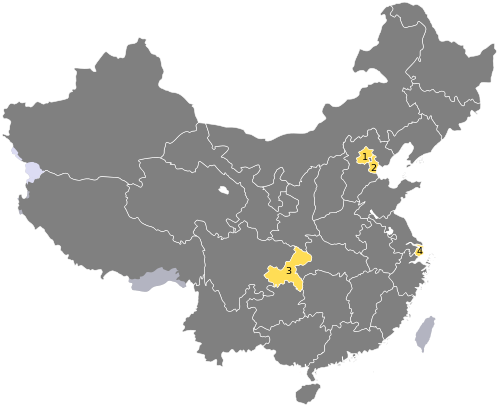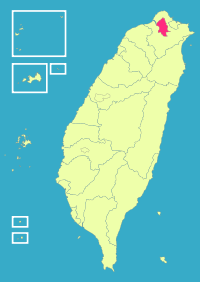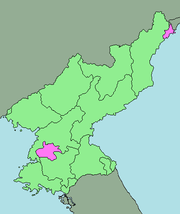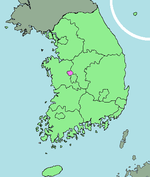Direct-controlled municipality
| Direct-controlled municipality | |||||||||||||||||||
|---|---|---|---|---|---|---|---|---|---|---|---|---|---|---|---|---|---|---|---|
| Chinese name | |||||||||||||||||||
| Traditional Chinese | 直轄市 | ||||||||||||||||||
| Simplified Chinese | 直辖市 | ||||||||||||||||||
|
|||||||||||||||||||
| Japanese name | |||||||||||||||||||
| Kanji | 直轄市 | ||||||||||||||||||
| Kana | ちょっかつし | ||||||||||||||||||
| Korean name | |||||||||||||||||||
| Hangul | 직할시/특별시/광역시 | ||||||||||||||||||
| Hanja | 直轄市/特別市/廣域市 | ||||||||||||||||||
|
|||||||||||||||||||
| Vietnamese name | |||||||||||||||||||
| Quốc ngữ | Thành phố trực thuộc trung ương | ||||||||||||||||||
| Hán tự | 城舖直屬中央 | ||||||||||||||||||
Direct-controlled municipality is the highest level classificiation for cities used by People's Republic of China, Republic of China (Taiwan), North Korea, South Korea and Vietnam with status equal to that of the provinces in the respective countries. The countries which were stated above adopt this system with some variations.
South Korea officials changed the title of Directly-Governed Cities into Metropolitan Cities (Special City for Seoul) in 1991.
Geographically and culturally, many of the municipalities are enclaves in the middle of provinces. Some occur in strategic positions in between provinces.
-
- P'yŏngyang, Rasŏn.
-
- Hà Nội, Hồ Chí Minh City, Đà Nẵng, and Hải Phòng, Cần Thơ.
Contents |
China
|
This article is part of the series: |
|
Provinces Autonomous regions Direct-controlled municipalities Special administrative regions |
|
Prefectures Autonomous prefectures Prefecture-level cities Leagues |
|
Counties Autonomous counties County-level cities City districts Banners Autonomous banners Forestry areas Special districts |
|
Townships Ethnic townships Towns Subdistricts Sumus Ethnic sumus District public offices (abolishing) |
|
Village Committees Neighborhood Committees |
|
History of the political divisions of China |
History
The first municipalities were the 11 cities of Nanjing, Shanghai, Beijing, Tianjin, Qingdao, Chongqing, Xi'an, Guangzhou, Hankou (now part of Wuhan), Shenyang, and Harbin when the ROC government ruled China. They were established in 1927 soon after they were designated as "cities" during the 1920s. Nominally Dalian was a municipality as well, although it was under Japanese Occupation. These cities were first called special municipalities/cities (Chinese: 特別市; pinyin: tébíeshì)), but were later renamed Yuan-controlled municipalities (simplified Chinese: 院辖市; traditional Chinese: 院轄市; pinyin: yùanxíashì), then direct-controlled municipalities (simplified Chinese: 直辖市; traditional Chinese: 直轄市; pinyin: zhíxiáshì) by the Central Government.
In 1949, after the Chinese Civil War, the PRC, Anshan, Benxi, and Fushun were made municipalities as well, while Qingdao, Dalian, and Harbin were reduced to provincial municipalities.[1] Hankou was merged to Wuhan. Hence there remained 12 municipalities, until Dalian was elevated in 1950. In November 1952, Nanjing was reduced to a provincial municipality.[2] In July 1953, Harbin was restored to municipality status, along with Changchun.[3] Except Beijing and Tianjin, which were under central control, all other municipalities were governed by the greater administrative areas.
In June 1954, 11 of the 14 municipalities were reduced to provincial municipalities; many of them became capitals of the provinces they were in. Only Beijing, Shanghai, and Tianjin remained municipalities, until Chongqing was restored in 1997 with a much enlarged area. Tianjin was also temporarily reverted to province-controlled status around the 1960s.
Position in hierarchy
Municipalities are the highest-ranked cities in the PRC. Some cities of lower levels may also refer to themselves as municipalities in the English language. Wikipedia's translation, however, refers to them using the following conventional terms:
Three levels of cities in the People's Republic of China:
- Municipalities
- Prefecture-level cities
- County-level cities
Administration
In municipalities, the highest ranking government official is the Mayor. The mayor is also a delegate in the National People's Congress (the legislature).[4] and Deputy Secretary of the CPC Municipal Committee. However, the highest administrative authority in the municipality belongs to the Secretary of the CPC Municipal Committee or Party Secretary.
Current PRC municipalities
 |
| Map # | Division name | Trad. | Simp. | Hanyu Pinyin | Postal | Abbr. | ISO[6] | Region | Population | Density (/km²) | Area (km²) | Divisions |
|---|---|---|---|---|---|---|---|---|---|---|---|---|
| 1 | Beijing | 北京 | 北京 | Běijīng | Peking | 京 jīng | CN-11 | North | 15,810,000 | 941 | 16,800 | List |
| 2 | Tianjin | 天津 | 天津 | Tiānjīn | Tientsin | 津 jīn | CN-12 | North | 11,519,000 | 980 | 11,305 | List |
| 3 | Chongqing | 重慶 | 重庆 | Chóngqìng | Chungking | 渝 yú | CN-50 | Southwest | 31,442,300 | 382 | 82,300 | List |
| 4 | Shanghai | 上海 | 上海 | Shànghǎi | Shanghai | 沪 hù | CN-31 | East | 18,450,000 | 2,622 | 6,341 | List |
List of defunct municipalities
| Name | Chinese (T) | Chinese (S) | Pinyin | Postal map | Region | Present Annexation |
|---|---|---|---|---|---|---|
| Nanjing | 南京 | 南京 | Nánjīng | Nanking | East | Jiangsu |
| Qingdao | 青島 | 青岛 | Qīngdǎo | Tsingtao | East | Shandong |
| Xi'an | 西安 | 西安 | Xī'ān | Sian | Northwest | Shaanxi |
| Guangzhou | 廣州 | 广州 | Guǎngzhōu | Kwangchou (Canton) | South Central | Guangdong |
| Hankou (Wuhan) | 漢口 | 汉口 | Hànkǒu | Hankow | South Central | Hubei |
| Shenyang | 瀋陽 | 沈阳 | Shěnyáng | Shenyang (Mukden) | Northeast | Liaoning |
| Harbin | 哈爾濱 | 哈尔滨 | Hāěrbīn | Harbin | Northeast | Heilongjiang |
| Dalian | 大連 | 大连 | Dàlián | Dairen | Northeast | Liaoning |
| Anshan | 鞍山 | 鞍山 | Ānshān | Anshan | Northeast | Liaoning |
| Benxi | 本溪 | 本溪 | Běnxī | Penhsi | Northeast | Liaoning |
| Fushun | 撫順 | 抚顺 | Fǔshùn | Fushun | Northeast | Liaoning |
|
|||||||||||||||||||
Taiwan
|
This article is part of
Administrative divisionsa series on the of the Republic of China |
||||||||||
| In effect | ||||||||||
|---|---|---|---|---|---|---|---|---|---|---|
| 1st | Provinces (省 shěng) (streamlined) |
|||||||||
| Municipalities (直轄市 zhíxiáshì) |
||||||||||
| 2nd | Counties (縣 xiàn) |
|||||||||
| Provincial cities (市 shì) |
||||||||||
| 3rd | Districts (區 qū) |
|||||||||
| County-controlled cities (縣轄市 xiànxiáshì) |
||||||||||
| Urban townships (鎮 zhèn) |
||||||||||
| Rural townships (鄉 xiāng) |
||||||||||
| 4th | Urban villages (里 lǐ) |
|||||||||
| Rural villages (村 cūn) |
||||||||||
| 5th | Neighborhoods (鄰 lín) |
|||||||||
|
Suspended
|
||||||||||
| Compare Administrative levels and divisions of the People's Republic of China |
||||||||||
History
Two municipalities in Taiwan were created after the ROC government took control following World War II. Taipei was made a Yuan-controlled municipality in 1967, then Kaohsiung was also elevated in 1979. Promotion of Taichung[7] and Tainan[8] from the provincial city to the third and fourth municipality was proposed and passed in 2009[9]. Since 1994, Yuan-controlled municipalities have been officially called direct-control municipalities to emphasize their autonomy. Besides significant political, economic, and cultural development, the ROC law dictates that a municipality must have population of over 1,250,000.
Position in hierarchy
Municipalities are the highest-ranked cities in the ROC. Some cities of lower levels may also refer to themselves as municipalities [10] , however, refers to them using the following conventional terms:
Three levels of cities in the Republic of China on Taiwan:
- Municipalities
- Provincial cities
- County-controlled cities
Administration
In Taiwanese municipalities, the mayor is the highest ranking official in charge. The mayor is directly elected by the people registered in the municipality for a duration of four years. e.g. Mayor of Taipei.
Current ROC municipalities
| Division name | Trad. | Simp. | Hanyu Pinyin | Abbr. | Seal | Population | Density (/km²) | Area (km²) | Divisions |
|---|---|---|---|---|---|---|---|---|---|
| Taipei City | 臺北市 | 台北市 | Táiběi Shì | 北 běi |
|
2,622,933 | 9,650.24 | 271 | List |
| Kaohsiung City | 高雄市 | 高雄市 | Gāoxióng Shì | 高 Gāo |
|
1,519,711 | 9,894.42 | 154 | List |
Approved ROC municipalities in 2010
| Map | No. | Division name | Trad. | Simp. | Hanyu Pinyin | Abbr. | Population | Area (km²) |
|---|---|---|---|---|---|---|---|---|
.svg.png)
1
2
3
4
5
|
1 | Taipei City | 臺北市 | 台北市 | Táiběi Shì | 北 běi | 2,622,933 | 271.7997 |
| 2 | Xinbei City | 新北市 | 新北市 | Xīnběi Shì | 新 xīn | 3,849,492 | 2,052.5667 | |
| 3 | Taichung City | 臺中市 | 台中市 | Táizhōng Shì | 中 zhōng | 2,629,323 | 2,214.8968 | |
| 4 | Tainan City | 臺南市 | 台南市 | Táinán Shì | 南 nán | 1,873,681 | 2,191.6531 | |
| 5 | Kaohsiung City | 高雄市 | 高雄市 | Gāoxióng Shì | 高 gāo | 2,769,072 | 2,946.2527 |
2014 Proposals for ROC municipalities[11]
| Changes | June 2009 Population - Combine |
Current Area (km²) - Combine |
Map (before) | Map (after) | ||
|---|---|---|---|---|---|---|
| Taipei City + Xinbei City + Keelung City → Taipei City (臺北市 + 新北市 + 基隆市 → 臺北市) |
6,854,715 | 2,457.1244 |  |
 |
 |
.svg.png) |
|
||||||||||||||||||||||||||||
North Korea
Position in hierarchy

Directly Governed Cities are the highest-ranked cities in North Korea.
The levels of cities in North Korea are:
- Directly Governed Cities
- Cities
Current North Korean directly-governed cities
| Division name | Chosŏn'gŭl | Hancha | Year of Split | Province split from | Population | Density (/km²) | Area (km²) | Divisions |
|---|---|---|---|---|---|---|---|---|
| P'yŏngyang Directly Governed City | 평양 직할시 | 平壤直轄市 | 1946 | P'yŏngannam | 3,255,388 | 1,019.2 | 3,194 | List |
| Rasŏn Special City | 라선 특별시 | 羅先特別市 | 2010 | Hamgyŏngbuk | 205,000 | 275 | 746 | List |
Note: North Korea uses a variant of the McCune-Reischauer romanization.
List of defunct directly-governed cities of North Korea
| Division name | Chosŏn'gŭl | Hancha | Province absorb into | Administered Years |
|---|---|---|---|---|
| Ch'ŏngjin City | 청진시 | 淸津市 | Hamgyŏngpuk | 1960–1967, 1977–1985 |
| Hamhŭng City | 함흥시 | 咸興市 | Hamgyŏngnam | 1960–1967 |
| Kaesŏng City | 개성시 | 開城市 | Hwanghaepuk | 1951–1955 |
| Namp'o Special City | 남포 특급시 | 南浦特級市 | P'yŏngannam | 1980–2004 |
|
||||||||||||||
South Korea
| Administrative divisions of South Korea |
|---|
| Provincial level |
| Province (道 도 do) |
| Special Self-governing Province (特別自治道 특별자치도 teukbyeol-jachido) |
| Special city (特別市 특별시 teukbyeol-si) |
| Metropolitan city (廣域市 광역시 gwangyeok-si) |
| Municipal level |
| City (市 시 si) |
| County (郡 군 gun) |
| District (區 구 gu) |
| Town (邑 읍 eup) |
| Township (面 면 myeon) |
| Neighbourhood (洞 동 dong) |
| Village (里 리 ri) |

Position in hierarchy
Special City and Metropolitan Cities are the highest-ranked cities in South Korea.
Two levels of cities in South Korea:
- Special City or Metropolitan Cities
- Cities
Administration
In South Korean special city and metropolitan cities, the Mayor is the highest ranking official in charge. The Mayor is directly elected by the people registered in the city for a duration of four years. e.g. Mayor of Seoul.
Current South Korean special city and metropolitan cities
| Division name | Hangul | Hanja | Year of Split | Province split from | Population | Density (/km²) | Area (km²) | Divisions |
|---|---|---|---|---|---|---|---|---|
| Seoul Special City | 서울 특별시 | 서울特別市 | 1067 | Gyeonggi | 10,464,051 | 17,288 | 605.25 | List |
| Busan Metropolitan City | 부산 광역시 | 釜山廣域市 | 1963 | Gyeongsangnam | 3,574,340 | 4,666 | 766.12 | List |
| Incheon Metropolitan City | 인천 광역시 | 仁川廣域市 | 1981 | Gyeonggi | 2,710,579 | 2,810.3 | 964.53 | List |
| Daegu Metropolitan City | 대구 광역시 | 大邱廣域市 | 1981 | Gyeongsangbuk | 2,512,604 | 2,842 | 884.15 | List |
| Gwangju Metropolitan City | 광주 광역시 | 光州廣域市 | 1986 | Jeollanam | 1,415,953 | 2,824 | 501.36 | List |
| Daejeon Metropolitan City | 대전 광역시 | 大田廣域市 | 1989 | Chungcheongnam | 1,442,857 | 2,673 | 539.84 | List |
| Ulsan Metropolitan City | 울산 광역시 | 蔚山廣域市 | 1989 | Gyeongsangnam | 1,126,879 | 1,030 | 1,056.4 | List |
- Notes
- There is no hanja for "Seoul," but in Chinese, it is written by its Joseon Dynasty name Hanseong (漢城). The new Chinese name, 首爾/首尔, is a transcription based on the pronunciation of "Seoul". As a suffix, the character gyeong (京) is used, which means "capital".
- Seoul was designated a "Special Free City" (Teukbyeol Jayusi; 특별 자유시; 特別自由市) separate from Gyeonggi Province on August 15, 1946; it became a "Special City" on August 15, 1949.
Proposed special autonomous city
| Division name | Hangul | Hanja | Year of Split | Province split from | Map |
|---|---|---|---|---|---|
| Sejong Special Autonomous City | 세종 특별자치시 | 世宗特別自治市 | TBD | Chungcheongnam |  |
|
||||||||||||||||||||
Vietnam

Position in hierarchy
Centrally-governed cities are the highest-ranked cities in Vietnam.
Three levels of cities in Vietnam:
- Centrally-governed cities
- Provincial cities
- Town
Current Vietnamese Centrally-governed cities
| Division name | Vietnamese | Chữ Nôm | Type | Region | Population | Density (/km²) | Area (km²) | Divisions |
|---|---|---|---|---|---|---|---|---|
| Hanoi | Thủ đô Hà Nội | 首都河內 | Special-class | Red River Delta | 6,500,000 | 1,943.4 | 3,344.7 | List |
| Ho Chi Minh City | Thành phố Hồ Chí Minh | 城舖胡志明 | Special-class | Dong Nam Bo | 7,162,864 | 8,851 | 809.23 | List |
| Can Tho | Thành phố Cần Thơ | 城舖芹𡮲 | 1st-class | Mekong Delta | 1,121,000 | 807 | 1,389.6 | List |
| Da Nang | Thành phố Đà Nẵng | 城舖沱灢 | 1st-class | Nam Trung Bo | 887,069 | 599 | 1,256 | List |
| Hai Phong | Thành phố Hải Phòng | 城舖海防 | 1st-class | Red River Delta | 1,884,685 | 1,250.1 | 1,507.57 | List |
|
||||||||||||||
References
- ↑ 中华人民共和国行政区划(1949年)
- ↑ 中华人民共和国行政区划(1952年)
- ↑ 中华人民共和国行政区划(1953年)
- ↑ Chongqing Mayor: Government Must Place Service Above Anything Else
- ↑ 5.0 5.1 5.2 5.3 References and details on data provided in the table can be found within the individual municipality articles.
- ↑ ISO 3166-2:CN (ISO 3166-2 codes for the provinces of China)
- ↑ Cabinet approves mergers, upgrades for counties, cities
- ↑ Tainan city, county win status as special municipality
- ↑ 4 new special municipalities to be created
- ↑ Amendment to Statute For Judicial Mediation In Prefectures, Towns And Cities. http://www.glin.gov/view.action?searchDetails.queryType=BOOLEAN&searchDetails.subjectTerms=&searchDetails.queryString=subterm%3Aequals%28%22en+Judicial+review%22%29&searchDetails.searchLaws=false&searchDetails.showSummary=true&searchDetails.searchLegislativeRecord=false&searchDetails.includeNumberFields=false&searchDetails.offset=0&searchDetails.offset=2670&refineQuery=provincial+taiwan+&searchDetails.publicationDateTo=&refineQueryType=ALL&searchDetails.includeAbstractFields=false&searchDetails.sortOrder=default&searchDetails.issuanceDateFrom=&refine=Refine+Search&fromSearch=true&searchDetails.includeTitleFields=false&searchDetails.andSubjectTerms=false&searchDetails.publicationDateFrom=&searchDetails.publicationLanguage=&glinID=78247&searchDetails.searchLegalLiterature=false&searchDetails.publicationJurisdictionExclude=false&searchDetails.includeAllFields=false&searchDetails.searchJudicialDecisions=false&searchDetails.includeNameFields=false&searchDetails.summaryLanguage=&searchDetails.searchAll=true&searchDetails.issuanceDateTo=&searchDetails.activeDrills=&searchDetails.hitsPerPage=10.
- ↑ http://www.taipeitimes.com/News/front/archives/2009/06/25/2003447086
|
||||||||||||||||||||

